Enviro Group Urges Targeted Crop Insurance Subsidies; End to Excluding Low Yield Years

U.N. group urges $25 billion fund to help poor nations deal with surge in food prices
|
In Today’s Digital Newspaper |
Russian president Vladimir Putin declared this morning that his military had “liberated” Mariupol, a key port city in southeastern Ukraine. Putin has heavily targeted the city throughout the war, as its capture would provide Russia with a link between Crimea (the territory it annexed in 2014) and the eastern Donbas region. About 2,000 Ukrainian troops remain holed up at a steel plant in Mariupol. Putin said he would not storm the plant, instead launching a blockade to choke off the remaining soldiers’ access to resources. Meanwhile, Russia announced on Wednesday that it had successfully test-launched a new intercontinental ballistic missile, the country’s latest nuclear saber-rattling. Putin said the “truly unique weapon” would “force all who are trying to threaten our country...to think twice.” Ukraine asked world finance officials gathering in Washington for more funding, saying it needs $5 billion a month to cover essential government services and keep its economy functioning.
The U.S. announced a new set of sanctions, targeting a Russian commercial bank and a crypto mining company. Meanwhile, Treasury Secretary Janet Yellen walked out of a G20 meeting in protest when Russia’s finance minister began to speak.
More old- and new-crop corn, soybean sales to China. Weekly Export Sales data for the week ended April 14 showed continued sales of U.S. corn and soybeans to China, both for old- and new-crop delivery. We have details in China section.
The U.N.’s FAO wants the world to create a fund of up to $25 billion to help poor nations deal with the surge in food prices caused by Russia’s invasion of Ukraine.
Chinese President Xi Jinping proposed a "global security initiative" that upholds the principle of "indivisible security", although he gave no details of how it would be implemented.
Fed Chairman Jerome Powell could seal expectations of a half-point rate rise in May during a public appearance today. Today’s dispatch details rising inflation not only in the United States but other countries. And we note the Federal Reserve should learn from inflation remarks during Tesla’s earnings call. Also, accelerating wage inflation in the technology sector is pressuring companies to boost compensation for key roles by 20% or more as they compete for a limited pool of workers skilled in areas such as cloud computing and data science.
Soaring U.S. interest rates have propelled the dollar to its strongest in nearly two years. The dollar has added 10% against the Japanese yen and 5% against the euro this year.
U.S. home prices in March were up 15% from a year ago, an increase that is expected to contribute to a slowdown in home sales. $375,300 is the median existing-home price in March.
Exports of U.S. crude and petroleum products surged to a record last week as countries work to replace Russian supplies. Meanwhile, Shipping data show a large number of vessels due to discharge Russian energy cargoes in Europe and the U.K. this month. Germany says it is looking to stop oil imports from Russia by the end of the year and reduce its gas imports from Moscow.
On the ag policy front, targeted crop insurance subsidies were urged by an environmental group, the latest of possible changes for the popular program ahead.
Activist investor Carl Icahn said BlackRock and other ESG-minded investors should back his McDonald’s campaign — Icahn is running a proxy fight for two McDonald's board seats over the fast-food chain’s pig policies.
Tesla made a $3.3 billion profit in the first three months of the year, up from $438 million a year earlier and the biggest quarterly profit since the company’s creation. Tesla sold 310,000 vehicles in the first quarter, up almost 70 percent from a year earlier. Tesla said it resumed “limited production” in Shanghai after a three-week shutdown, but “persistent” supply-chain problems and the rising cost of raw materials mean that it expects its factories to run below capacity for the rest of 2022.
Nestlé, the world’s largest food company, raised prices steeply, suggesting that inflation will persist.
California almond growers are among U.S. agricultural exporters frustrated by the lack of capacity on outbound container ships.
The Justice Department announced plans to appeal a federal judge’s decision overturning the mask mandate for public transportation, after the CDC said the mandate “remains necessary for the public health.”
President Emmanuel Macron of France and his far-right rival Marine Le Pen went head-to-head in a debate last night, ahead of the country’s presidential runoff election on Sunday. The latest polls give Macron 55% of the vote over Le Pen’s 45%, but the margin has narrowed recently. Macron said Le Pen was in the pocket of Russia. He alluded to a multimillion-euro loan from a Russian bank to Le Pen’s National Rally party, formerly the National Front, in 2014. The loan is still not repaid and is now held by a company with ties to the Russian military. “When you speak to Russia, you speak to your banker,” Macron said. Ouch…
In the U.S., Election Day 2022 is 201 days away. Election Day 2024 is 929 days away.
Washington Nationals miscommunication caused a brief national security evacuation… whoops!
|
MARKET FOCUS |
Equities today: Global stocks markets were mostly higher overnight. The U.S. Dow opened around 250 points higher. Asian equities finished mixed amid a focus on inflation, Ukraine situation. The Nikkei rose 335.21 points, 1.23%, at 27,553.06. The Hang Seng Index was down 262.45 points, 1.25%, at 20,682.22. European equities have moved higher in early trade action, with all regional markets in positive territory. The Stoxx 600 was up 0.8% with regional markets up 0.2% to 1.8%.
U.S. equities yesterday: There was a mixed finish for U.S. stock indices, with tech-related shares giving back some of their solid gains from Tuesday. The Dow gained 249.59 points, 0.71%, at 35,160.79. The Nasdaq fell 166.59 points, 1.22%, at 13,453.07. The S&P 500 eased .276 points, 0.06%, at 4,459.45.
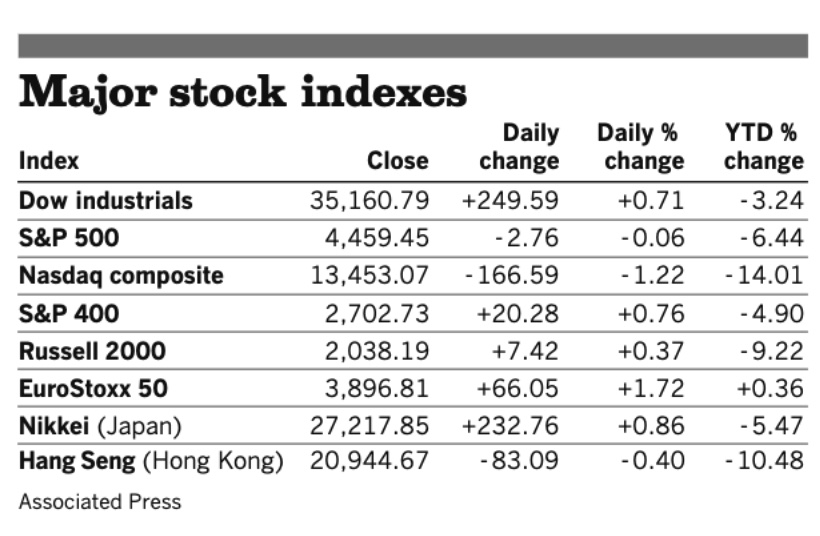
Agriculture markets yesterday:
- Corn: July corn futures rose 9 3/4 cents to $8.09 1/2, while May futures rose 11 3/4 cents to $8.15 3/4, the highest settlement for a nearby contract since August 2012. Soy complex: July soybeans rose 25 1/4 cents to $17.17, while May futures rose 30 1/4 cents to $17.46 3/4, the highest settlement for a nearby contract since September 2012. July soymeal surged $6.70 to $466.30 and July soyoil gained 55 points to 78.75 cents.
- Wheat: July SRW wheat fell 11 1/2 cents to $10.97 1/2, the contract’s lowest closing price since April 11. July HRW wheat fell 6 3/4 cents to $11.69 1/2. July spring wheat ended unchanged at $11.72 1/4.
- Cotton: July cotton rose 55 points to 138.88 cents per pound, while new-crop December futures edged up 7 points to 121.02 cents.
- Cattle: June live cattle rose $2.05 to $138.625, the contract’s highest closing price since Feb. 23. May feeder cattle rose $1.70 to $162.475. Live cattle closed near a two-month high behind strength in the cash market.
- Hogs: June lean hog futures fell $2.575 to $118.75. Pork cutout values jumped early yesterday before ending the day down $2.37 at $107.12.
Ag markets today: Wheat futures extended Wednesday’s losses overnight. Corn and soybeans posted two-sided trade, with corn weaker and soybeans firmer early this morning. As of 7:30 a.m. ET, corn futures were trading 2 to 4 cents lower, soybeans were fractionally to 3 cents higher, winter wheat futures were mostly 6 to 9 cents lower and spring wheat was mostly 1 to 3 cents lower. Front-month U.S. crude oil futures were around $1 higher and the U.S. dollar index was about 200 points lower this morning.
Technical viewpoints from Jim Wyckoff:


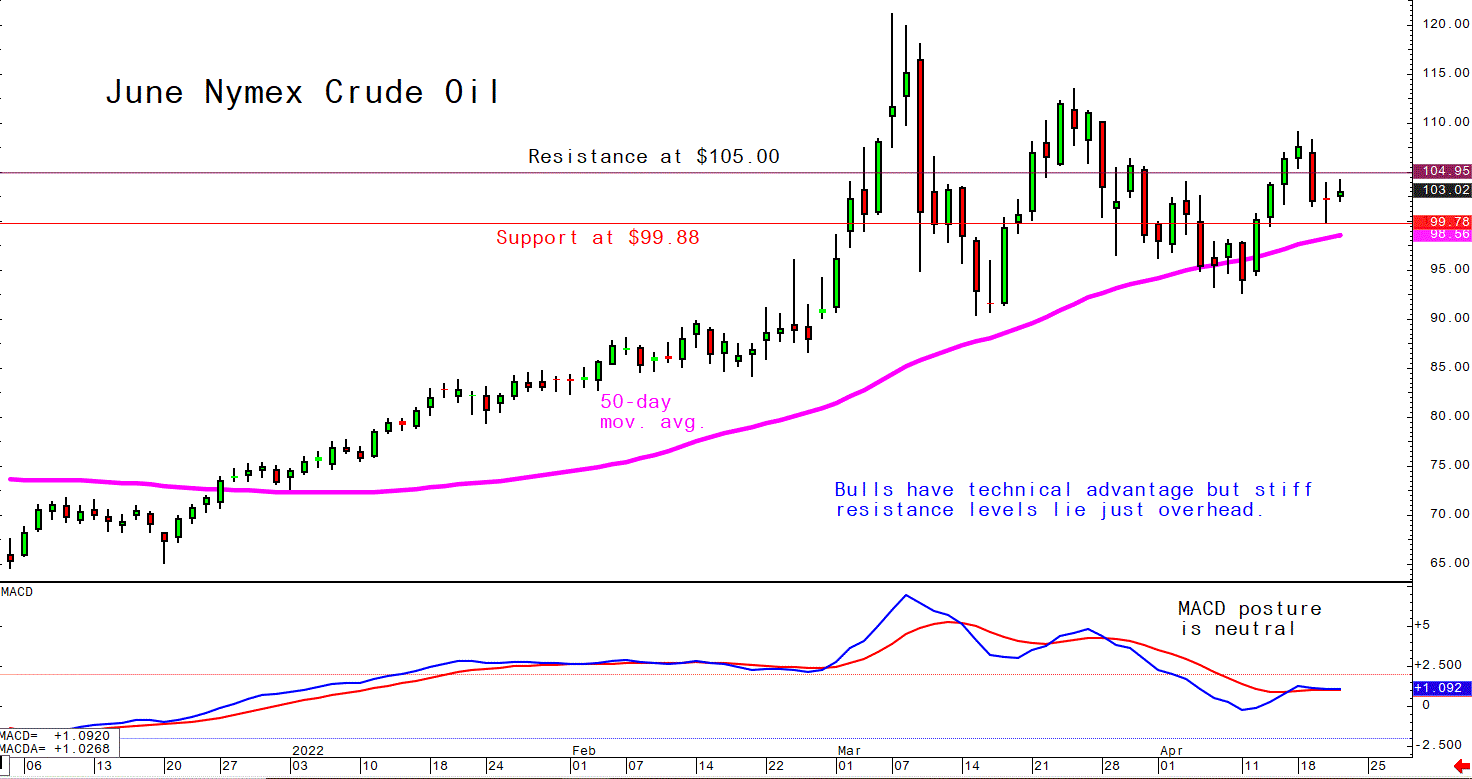
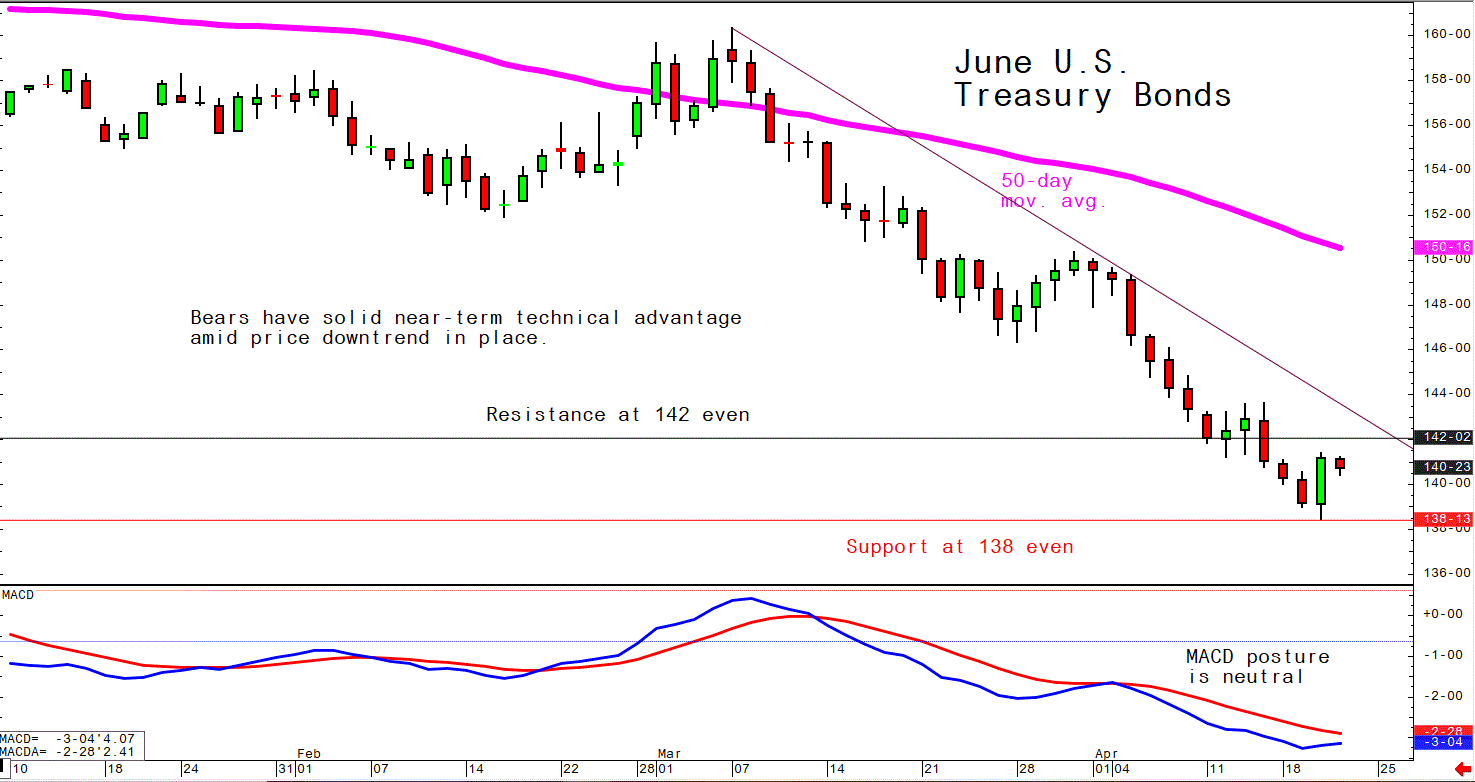

On tap today:
• U.S. jobless claims, due at 8:30 a.m. ET, are expected to fall to 182,000 in the week ended April 16 from 185,000 one week earlier.
• Philadelphia Fed's manufacturing survey, due at 8:30 a.m. ET, is expected to fall to 21.9 in April from 27.4 one month earlier.
• USDA Weekly Export Sales report, 8:30 a.m. ET.
• Conference Board's leading economic index for March, due at 10 a.m. ET, is expected to increase 0.2% from the prior month.
• Federal Reserve Chairman Jerome Powell and European Central Bank President Christine Lagarde take part in an International Monetary Fund panel on the global economy at 1 p.m. ET.
Comments by Fed’s Powell awaited as Fed’s Beige Book signals inflationary pressures. Fed Chair Pro Tempore Jerome Powell delivers remarks today at the International Monetary Fund (IMF)/World Bank spring meetings in Washington, with attention focused on what signals he sends about what the Fed will do at the May 3-4 Federal Open Market Committee (FOMC). The attention will be on whether he delivers remarks that are viewed a confirming market expectation that the Fed will increase the target range for the Fed funds rate by 50 basis points at that meeting. Powell has been more prone to providing signals on monetary policy decisions than some of his predecessors as he has pledged markets will not be surprised by Fed actions. Powell may well deploy a caveat that data will drive the decisions, but Powell and others have signaled fighting inflation is their primary focus.
Meanwhile, the Fed’s Beige Book released Wednesday was replete with observations from businesses across the 12 Fed districts that outlined rising prices and expectations the outlook was clouded by the Russian invasion of Ukraine and the prospect of higher interest rates.
Federal Reserve should look at Tesla to figure out inflation. Tesla’s quarterly earnings beat was driven by the car maker’s ability to pass on rising costs to eager customers. It shone through in an operating margin of 19.2%, which has swollen from 5.7% a year ago. With some suppliers asking for 20%-30% increases for parts, Musk believes inflation could be higher than the stated 8.5%. Meanwhile, Tesla beat first-quarter expectations, reporting how it beat inflation by substituting materials and focusing on manufacturing. Tesla said it expects to operate below capacity for the next few quarters, in part because its Shanghai factory temporarily closed last month during Covid-19 lockdowns. But it still expects to achieve an average annual growth rate of 50% in vehicle deliveries over the next several years.

Wage inflation in the technology sector is accelerating, pressuring companies to boost compensation for key roles by 20% or more as they compete for a limited pool of workers skilled in areas such as cloud computing and data science.
Eurozone inflation jumps to another record. Eurozone consumer inflation rose to a record 7.4% above year-ago in March amid a 44.4% surge in energy prices. Excluding energy and unprocessed food prices, consumer inflation hit a record 3.4% above year-ago. Meanwhile, Germany's annual producer price inflation topped 30% in March — the highest level since the agency began collecting data 73 years ago.
Impacts: Traders are betting the European Central Bank will raise rates above zero this year for the first time since 2012. Money markets are pricing 75 basis points of interest-rate hikes by the ECB’s December decision, according to swap contracts linked to the euro short-term rate. The ECB should be able to phase out asset purchases in July to pave the way for an interest-rate increase as early as that month, according to Vice President Luis de Guindos.
Canada’s annual inflation rate reached a fresh three-decade high in March. The country's consumer price index advanced 6.7% on a year-over-year basis last month, Statistics Canada said Wednesday, the highest since January of 1991. Several analysts said the latest inflation data suggests Canada’s central bank — which last week raised its benchmark overnight interest rate by a half-percentage-point, to 1.0% — could announce another half-percentage point increase in June.

New Zealand reported inflation in the first quarter of 2022 rose at an annualized rate of 6.9%, up from 5.9% in the fourth quarter and the highest since the third quarter of 1990. The Reserve Bank of New Zealand raised rates to 1.5% April 13, an increase of 50 basis points, and said additional increases will be needed to get ahead of inflation.
U.S. home prices soared to a new record in March while mortgage rates continued to rise rapidly, slowing home sales in what has been the hottest housing market in more than 15 years. The median existing-home price was $375,300, up 15% from the year before. Existing-home sales fell 2.7% last month from February, the National Association of Realtors said. With mortgage rates at 5% and back to their highest level since 2011, some analysts expect home sales in 2022 to decline 10% from last year.
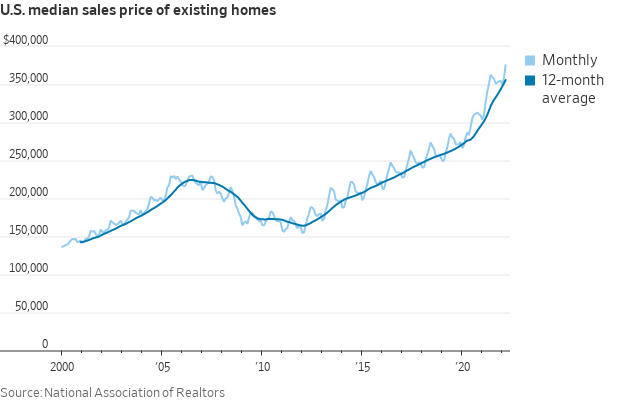
Market perspectives:
• Outside markets: The U.S. dollar index was slightly lower ahead of U.S. economic updates, with strength in several foreign currencies versus the greenback. The yield on the 10-year U.S. Treasury note is weaker, around 2.85%, while there is a mostly lower tone in global government bond yields. Gold and silver futures are under pressure amid gains in stock index futures ahead of U.S. trading. Gold is trading around $1,940 per troy ounce and silver around $24.70 per troy ounce.
• The dollar reached fresh nearly two-year highs, lifted by looming interest-rate increases from the Federal Reserve, strong U.S. growth and geopolitical concerns overseas.
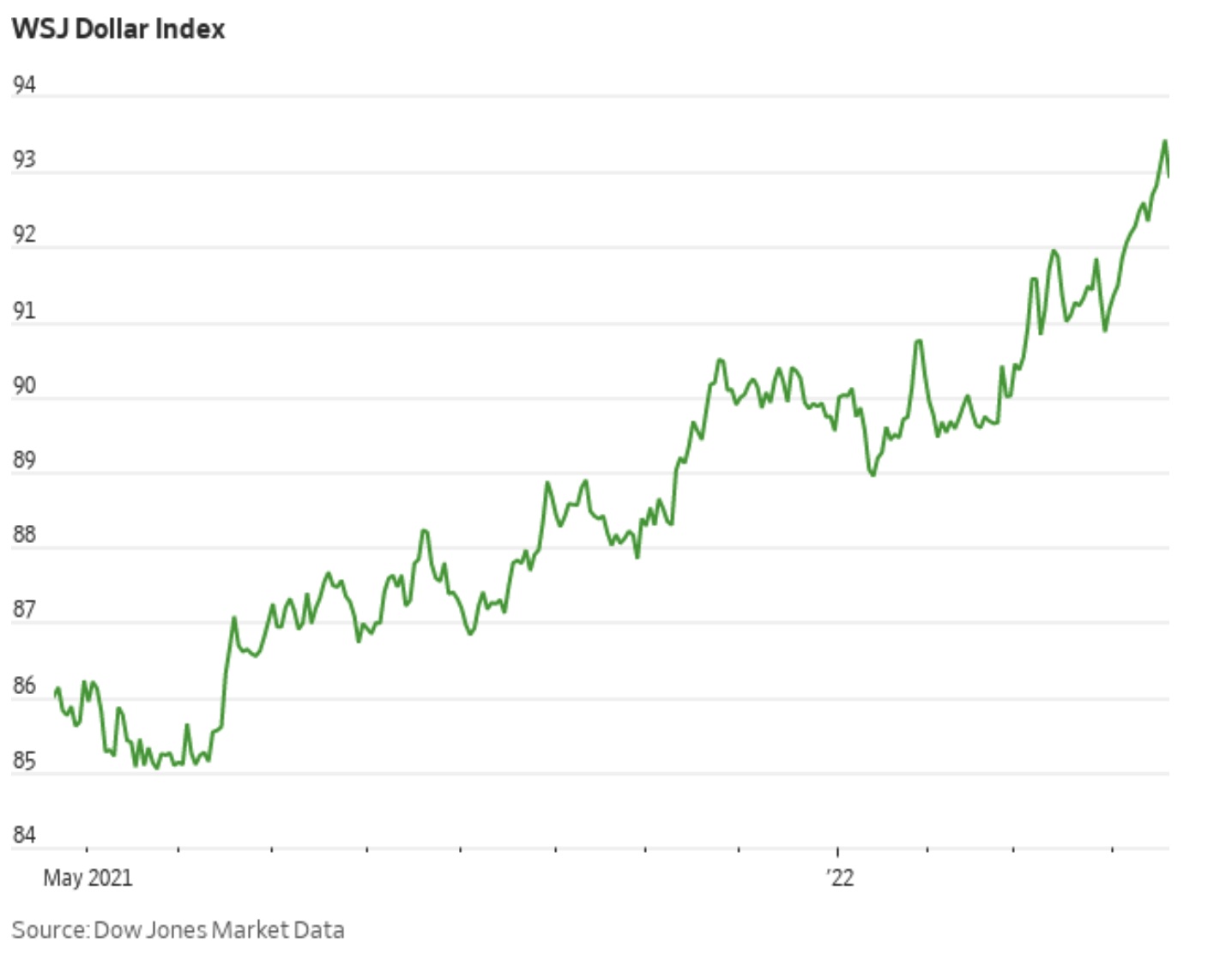
• Crude oil futures are higher, with gains in Brent outpacing those for U.S. crude. WTI crude is trading around $103.30 per troy ounce while Brent is around $108. Futures traded near those marks in Asian action.
• The U.S. is coming off an all-time high for weekly oil exports. Total volume of US oil and petroleum cargoes hit 10.6 million barrels a day in the week leading up to April 15, new data revealed. Plus, US exports outweighed imports by the largest-ever margin, according to Bloomberg.
• Pakistan plans to import 3 million tons wheat to meet demand. The government forecasts domestic harvest to fall by about 7% from the target of 28.9 million tons this year, Business Recorder reports (link), citing unidentified people. The food security ministry proposes to buy 2 million tons of grain on government-to-government basis from Russia and the remaining by offering international tenders.
• California almond growers are among U.S. agricultural exporters frustrated by the lack of capacity on outbound container ships. Throughout California, more than 1.1 billion pounds of almonds from last year’s harvest are sitting in warehouses, a volume roughly one-third larger than this time last year, according to the Almond Alliance of California, an industry trade group. Link to details via the NYT.
• Ag trade: Taiwan purchased 47,120 MT of U.S. milling wheat. Japan purchased 27,320 MT of Australian wheat from its weekly tender.
• More than 8 million people are currently under fire alerts with areas across New Mexico, western Texas, and portions of Nebraska and Wyoming under critical fire risk. This comes because of extremely dry conditions, low humidity, gusty winds and near record-setting high temperatures across the Southwest U.S. There are 11 large wildfires burning across the region. It has been an extraordinarily busy start to the fire year in the South and Southwest, with more than 19,000 wildfires reported through Tuesday, according to the National Interagency Fire Center. This is the highest number of fires at this time of the year in any year of the past decade.
• NWS weather: Strong upper low to bring cool and wet weather to the West Coast today, then spawn another late season winter storm in the northern High Plains & Rockies to kick off the weekend... ...Summer-like warmth for parts of the Front Range, Southwest and Southern Plains through Friday; Extreme Risk of fire weather conditions in parts of eastern Colorado and central New Mexico on Friday... ...Multi-day stretch of severe weather in the Heartland; warming trend from the Mississippi Valley and Ohio Valley to the Southeast and Mid-Atlantic.
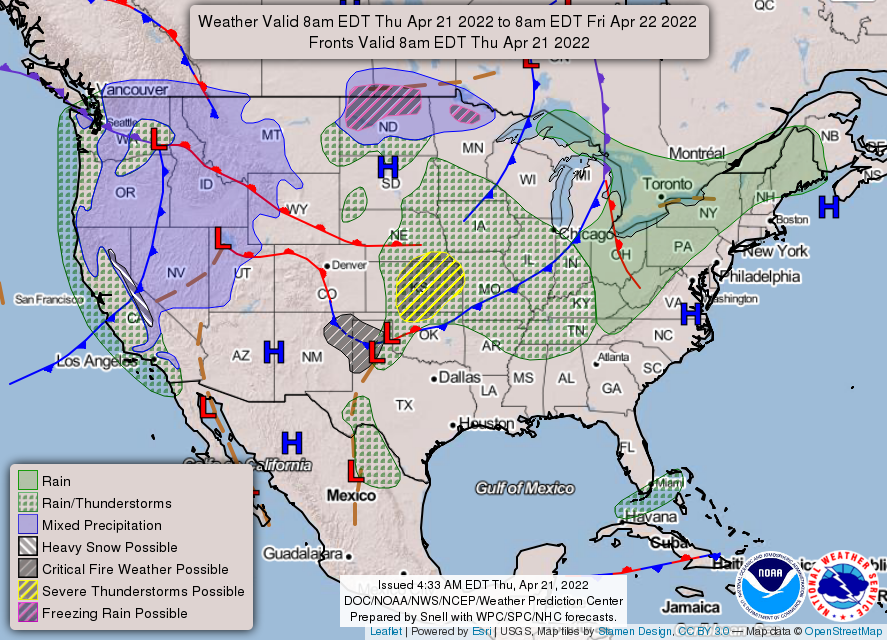

Items in Pro Farmer's First Thing Today include:
• Corn and wheat weaker, soybeans mildly firmer this morning
• China slows bean buying due to poor crush margins (details in China section)
• Exchange raises Argentine crop estimates
• Cash cattle trade shows more strength
• Cash hog index climbs again
|
RUSSIA/UKRAINE |
— Summary: Russia test-launched a new intercontinental missile that it said could carry several nuclear warheads, a warning to the U.S. and Europe. Some in the White House worry it’s a sign that Putin’s isolation is making him reckless, the NYT writes (link). In Ukraine, Russia said it had fired artillery, missiles and bombs at more than 1,100 targets. It also made probing attacks along the eastern front but has not started a full assault. Treasury Secretary Janet Yellen walked out of a G20 meeting as Russia’s finance minister spoke. President Biden today at 9:45 a.m. ET will deliver an update on Russia’s war in Ukraine.
- The Ukrainian Air Force has added about 20 more operational aircraft to its fleet because of an influx of spare parts, according to a senior US defense official, which will help strengthen the country’s aerial defense network.
- Russia test-launched a new intercontinental ballistic missile, known as “Satan 2”, intended to replace a Soviet-era ICBM. Vladimir Putin, Russia’s president, said the test would “give thought to those who are trying to threaten Russia”. According to the country’s defense ministry, the missile was launched from the Arkhangelsk region in north-western Russia and landed on the Kamchatka peninsula, in the Far East. A Pentagon spokesman said Russia had informed America about the test beforehand.
- Germany’s chancellor, Olaf Scholz, is under intense pressure at home and abroad because of his refusal to send heavy weapons, such as tanks and submarines, to Ukraine. This week he tried to deflect the criticism by saying that his government was supporting German arms manufacturers, even while admitting his army had nothing left to offer.
— Market impacts:
- Russia came closer to default after a swaps watchdog ruled against ruble payments. The 14 counterparties that oversee the credit-default swaps market, including investment banks, asset managers and brokerage firms, ruled unanimously on Wednesday that Russia fell short of fulfilling its debt obligations. Moscow could still avert a default if it pays bondholders in dollars before the grace period ends on May 4.
- Russia’s centra bank may further cut rates at upcoming meetings, Governor Elvira Nabiullina said during a session with the Russian Duma. "We will consider the possibility of its further reduction at upcoming meetings," Nabiullina said, warning the country was going to see structural changes ahead caused by the sanctions levied by the West over its invasion of Ukraine. "Problems may arise even when there is a production with a high degree of localization, when there has already been a fairly high import substitution," Nabiullina said. The Russian central bank raised rates to 20% in late February to stabilize the ruble and thwart inflation. The rate was cut to 17% in April, but it is clear from Nabiullina’s remarks that further reductions are ahead.
- Ukraine has planted some 2.5 million hectares of spring-planted crops so far this year, 20% of expected area, according to the Ukrainian ag ministry. The country has warned of a potential decline of 20% in plantings this year due to the Russian invasion, and reports quoted ag ministry officials as saying the drop could be 30% to 40% in the northern areas of the country as mines will need to be removed. In areas that are temporarily occupied, a ministry official was quoted as saying plantings could fall by 60% to 70%.
|
POLICY UPDATE |
— Targeted crop insurance subsidies were urged by an environmental group, the latest of possible changes for the popular program ahead. The Natural Resources Defense Council (NRDC) wants changes in federal farm programs to promote the use of “regenerative” agriculture practices such as cover crops. The suggestions come in a report (Link) released today. Regarding crop insurance, the report notes that farmers should get a higher premium subsidy or lower premium rate for practices that improve soil health. It recommends extending the $5-an-acre cover crop subsidies that the Biden administration initiated last year and continued in 2022.
An NRDC suggestion that will prove very unpopular in the ag sector: The activist group says farmers should no longer be allowed to exclude some bad years from their yield histories, a move that would reduce those growers’ coverage.
Perspective: One observer says: “The NRDC’s proposals are at odds with the Biden administration’s commitment to ensure that agriculture’s role in carbon sequestration and reduction is voluntary and incentives based. Crop insurance policies ought to be rated based on insurance principles, not matters that can and should be addressed by the suite of conservation programs. The $5 per acre discount for producers that plant cover crops has been accepted because it has not been an intrusive approach that upends the rating of premiums. Going beyond this approach will meet with strong opposition. The NRDC proposal to eliminate the various means of addressing lagging APHs will also meet with strong opposition. These have enjoyed broad bipartisan support as has crop insurance generally. NRDC’s causes would be better served if it worked with producers on voluntary, incentives-based approaches rather than resorting once again to the stick. The approach will backfire and set back their cause.”
|
CHINA UPDATE |
— More old- and new-crop corn, soybean sales to China. Weekly Export Sales data for the week ended April 14 showed continued sales of U.S. corn and soybeans to China, both for old- and new-crop delivery. Net sales activity for 2021-22 included net sales of 675,302 tonnes of corn, 13,492 tonnes of sorghum, 496,368 tonnes of soybeans and 4,651 running bales of upland cotton. Sales for 2022-23 were reported for 340,000 tonnes of corn and 669,000 tonnes of soybeans. Activity for 2021 delivery included net sales of 2,485 tonnes of beef and net reductions of 93 tonnes of pork.
— China’s Xi Jinping blasts ‘cold war mentality’. China President Xi Jinping said China will firmly oppose decoupling, while its economy can play a lead role in global recovery as the world stands at a crossroads between the coronavirus pandemic, trade conflicts and war in Ukraine. In a speech today, Xi called for stronger macro coordination between major economies to prevent “severe and negative” spillover effects from policy decisions and to help stabilize the global supply chain. He said China “offers powerful momentum” for recovery from the pandemic, while playing down concerns about the economic impact of Beijing’s hardline virus control measures. Xi also proposed a Chinese-led global security initiative based on the United Nations framework, renounced unilateral action and confrontation and promoted non-interference and respect for sovereignty and territorial integrity.
— IMF: Prolonged China slowdown a risk to global economy. A prolonged slowdown in China would have substantial global impacts, IMF Managing Director Kristalina Georgieva said, though she noted Beijing has room to adjust policy to provide support. “Fortunately, China has policy space to provide macroeconomic policy support, including shifting the focus toward vulnerable households to strengthen consumption, which can also help support China’s climate goals by steering economic activity to lower-carbon sectors,” Georgieva added. “Stronger policy efforts in the property sector can also help secure a balanced recovery.” China’s commerce ministry said today it would roll out targeted measures to boost a recovery in consumption. Spending has been hit hard by lockdowns across the country that began last month to contain the spread of Covid.
— China slows bean buying due to poor crush margins. Chinese crushers have slowed their soybean purchases for summer delivery amid poor production margins. Traders told Reuters only 20% of China’s soybean needs for June-September, which are expected to be 7 MMT to 8 MMT per month, have been covered. But buying isn’t expected to pick up unless margins improve. Crush margins for U.S. and Brazilian soybeans delivered in June and July at current prices are negative, while margins for August arrivals are only mildly profitable. Demand for soymeal is weak as hog farmers and poultry producers are using alternatives for feed.
|
ENERGY & CLIMATE CHANGE |
— Canada canola demand seen rising on proposed U.S. EPA fuel rule. A potential move by the U.S. to allow canola oil as feedstock for renewable diesel will boost demand for Canadian canola, said Jim Everson, Canola Council of Canada president. Currently, about 5% to 8% of Canadian canola output is used as a biofuel in Canada, U.S. and Europe. That could rise to as much as 20% by 2030, Everson said. The industry goal is to boost production to 26 million tons by 2025, from 12.6 million tons in 2021. EPA released a proposed decision that canola oil-derived renewable diesel, jet fuel and other biofuels qualify as “advanced biofuels” under the Renewable Fuel Standard program. Canada is the world’s largest canola grower.
— Green Plains touts ‘breakthrough’ in squeezing protein from corn. U.S. ethanol maker Green Plains Inc. says its focus on producing high-value ingredients made from corn has led to greater than 60% protein concentrations from the grain. The “breakthrough” stems from a production changeover across the fermentation and production processes of the company’s plant in Wood River, Neb., the company said in a statement. “We believe that for the first time in history, a dry mill biorefinery has been able to achieve protein concentrations over 60% with yields approaching 4 pounds per bushel, which can drastically improve the economics of a biorefinery,” CEO Todd Becker said. The trial also resulted in “record-high” low-carbon renewable corn oil yields of up to 1.4 pounds per bushel. “We will continue to develop this process to fully transform our current operations while remaining on track to meet our 2024-25 objectives,” Becker said. Backer has been working to sharply reduce Green Plains’ reliance on ethanol, with an aim of fully remaking the company into a low-carbon manufacturer of high-protein and “clean sugar” ingredients for use in products ranging from pet food to candy, with biofuel merely a byproduct.
— State governments will be able to spend $6.4 billion on projects such as electric-vehicle charging stations, bike trails and energy-efficient streetlights under new guidelines for use of federal infrastructure money meant to reduce carbon emissions.
|
LIVESTOCK, FOOD & BEVERAGE INDUSTRY |
— The world should create a fund of up to $25 billion to help poor nations deal with the surge in food prices caused by Russia’s invasion of Ukraine, said the head of the U.N. Food and Agriculture Organization (FAO) on Wednesday. The FAO estimates that an additional 13 million people will face hunger in the near term because of warfare in the Black Sea region, usually a major source of wheat and corn on the world market. In a video message to G20 finance ministers and central bank governors, FAO director-general Qu Dongyu called for creating a Food Import Financing Facility to bolster food security. It would ease the immediate costs of financing food imports for low- and middle-income countries that are net importers of food.
The financing effort could be set up in a several ways and could start work with an initial $6.3 billion, said the FAO in a background paper. That would be enough to offer financing for 25 percent of current import costs. Alternately, the facility could base its assistance on additional purchasing costs that exceed $50 or $100 per person, which could cost $9.1 billion or $15.9 billion.
— Higher food and fuel prices are forcing some Californians to ask for help for the first time at food banks, and the California Association of Food Banks now says it will need twice as much money from the state as the governor proposed in January. Link to details via Los Angeles Times.
— Carl Icahn said BlackRock and other ESG-minded investors should back his McDonald’s campaign. The activist is running a proxy fight for two McDonald's board seats over the fast-food chain’s pig policies. McDonald’s shareholders will decide whether to support Mr. Icahn’s nominees or the company’s slate at the annual meeting set for May 26. At issue is how McDonald’s suppliers’ house breeding pigs, or sows. Icahn wants McDonald’s to require suppliers to stop constraining the animals in small crates in all circumstances. Many of McDonald’s suppliers currently use so-called gestation crates for the first four-to-six weeks of a sow’s pregnancy and sometimes longer. Suppliers have said they make breeding more efficient, while Icahn and his nominees say they are inhumane.
— Nestlé raises prices steeply, suggesting that inflation will persist. The world’s largest food company said today that the prices it charges for products rose by more than 5 percent on average in the first quarter, the biggest jump in that quarter since at least 2012. The largest increases, of more than 7 percent, were in pet food and bottled water.
— Additional commercial operations confirmed with HPAI. Additional commercial poultry operations have been confirmed by USDA’s Animal and Plant Health Inspection Service (APHIS) to have highly pathogenic avian influenza (HPAI), with a new find in Colorado which adds the state to the list with commercial operations with bird flu. The state previously had a backyard flock with HPAI. APHIS data shows 138 commercial operations and 75 backyard flocks with confirmed HPAI cases for a total of 28.81 million birds affected, but others note data point to 140 commercial flocks in 17 states have now been confirmed with HPAI.
|
CORONAVIRUS UPDATE |
— Summary: Global cases of Covid-19 are at 507,130,498 with 6,208,782 deaths, according to data compiled by the Center for Systems Science and Engineering at Johns Hopkins University. The U.S. case count is at 80,801,713 with 990,208 deaths. The Johns Hopkins University Coronavirus Resource Center said that there have been 570,485,199 doses administered, 219,047,079 have been fully vaccinated, or 66.73% of the U.S. population.
— DOJ to appeal court mask ruling. The Department of Justice (DOJ) announced Wednesday it would appeal the ruling by a federal judge that invalidated the mask mandate for public transportation after the U.S. Centers for Disease Control and Prevention (CDC) said the mandate is needed for public health. The CDC said it concluded that requiring “masks for the indoor transportation corridor remain necessary for public health.” CDC also said it would “continue to monitor public health conditions to determine whether such an order remains necessary.” The mask mandate can only be enforced now if the DOJ succeeds in its appeal. There is concern of some that if the judge’s decision stands, it could make it harder in the future for such a public-health-related action such as an increase in Covied infections and deaths. Next step: If the conservative-leaning appeals court upholds the order, the case could then be appealed to the Supreme Court, where conservative justices have been ruling against Covid-19 measures since the start of the pandemic.
|
POLITICS & ELECTIONS |
— Sanders not ruling out 2024 run. Sen. Bernie Sanders (I-Vt.) may run yet again for president. The Washington Post obtained a memo from top Sanders political hand Faiz Shakir saying that “in the event of an open 2024 Democratic presidential primary, Sen. Sanders has not ruled out another run for president.” Link for details.
— In a televised debate before France’s presidential election, Emmanuel Macron attacked Marine Le Pen for her affinity with Russia. Macron suggested that a loan taken by her party from a Russian-Czech bank in 2014 had made her biddable. “You speak to your banker when you speak to Russia,” said the French president. Meanwhile, Le Pen hammered Macron on cost-of-living issues and promised to “give the French their money back.”
|
OTHER ITEMS OF NOTE |
— U.S. Capitol was briefly evacuated on Wednesday when police warned of an aircraft that posed a “probable threat.” But it turned out the plane was being used for a performance by the Army’s Golden Knights, who were parachuting into the Washington Nationals stadium as part of a Military Appreciation Night. House Speaker Nancy Pelosi (D-Calif.) blasted the Federal Aviation Administration for failing to notify the Capitol Police of the performance, calling the oversight “outrageous and inexcusable.” Pelosi promised the agency would be held accountable for the “frightening mistake.”






